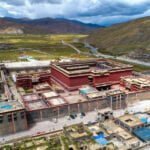The Enchanting Nyigo Monastery
Nestled in the northeastern reaches of Mangkang County, within the Zongxi Township, lies the serene Nyigo Monastery (Hyin-mgo-dgon). In Tibetan, “Nyigo” signifies the “Crown of the Sacred Mountain,” a name that reflects the monastery’s lofty elevation of 4,250 meters and its divine essence. Adherents of the Nyingma sect of Tibetan Buddhism have revered this site since its inception in the early 17th century.
A Cave of Rainbows
The monastery’s origins trace back to a solitary cave, 3 miles from the current site, where the Lama Milarepa meditated. It’s said that upon passing, his body transformed into a vibrant rainbow within this cave, which has since been known as the “Rainbow Cave.”
Mid-17th century, Lama Jetsun Chögyal Gyatso established the Nyigo Monastery near this mystical site. Over two centuries, successive lamas and monks have expanded the monastery. Among the notable contributions are a temple by Lama Renzin Dondup Dorje and a nine-story statue of Guru Padmasambhava (Lotus Born Master) created by Lama Renzin Longsa Ningpo through divine powers. The concept of “Good Living,” a comprehensive consecration of the mountain, Buddhas, halls, and scriptures, was introduced by Lama Men Lama Dashidorje in the 18th century, involving the induction of sacred objects and deities to dwell within the monastery’s precincts.
Generations of Nyingma scholars and practitioners have left a wealth of religious artifacts here, including a 36-meter tall statue of Guru Padmasambhava, stupas, naturally formed Buddha images, thrones, Tara, historical horses of past Buddhas, footprints, and scriptures. Sadly, the Cultural Revolution saw the destruction of nearly all relics except the mani stone piles. The monastery standing today was reconstructed in the 1970s. It now hosts 65 monastics, including 32 lamas and 33 nuns.
The Mani Stone Piles of Nyigo
The Mani stone piles around Nyigo Monastery are remarkable for their vast scale, covering an area of 2-3 kilometers. These intricately carved stones, rich in history and artistry, continue to be a subject of both devotion and archaeological interest, with new carvings being added regularly.
The Nyigo Natural Scenic Area
Established in 1990 with the monastery at its heart, the Nyigo Natural Scenic Area is a treasure trove of religious sites, including over ten meditation caves and two naturally formed Guru Padmasambhava statues (8 meters high in the front mountain and 3 meters in the back). The area becomes a pilgrimage hotspot during the annual Saga Dawa festival, drawing countless devotees.
Additionally, the scenic area is home to various wildlife species, including first and second-class protected animals like deer, bears, leopards, blue sheep, blood pheasants, and Tibetan snowcocks. Visitors can feed these animals with barley and salt and even take photos with them, as they are quite approachable.
Visiting Tips
- Admission: Entrance is free, with voluntary offerings welcomed.
- Getting There: The monastery is about 70 kilometers from the county town. Visitors can rent a car for 200 to 300 yuan (for reference) to explore both the monastery and the Nyigo Natural Scenic Area.
Nyigo Monastery offers a unique blend of spiritual sanctity, historical depth, and natural beauty, making it a must-visit for anyone seeking to explore the rich cultural and religious tapestry of Tibet.
















